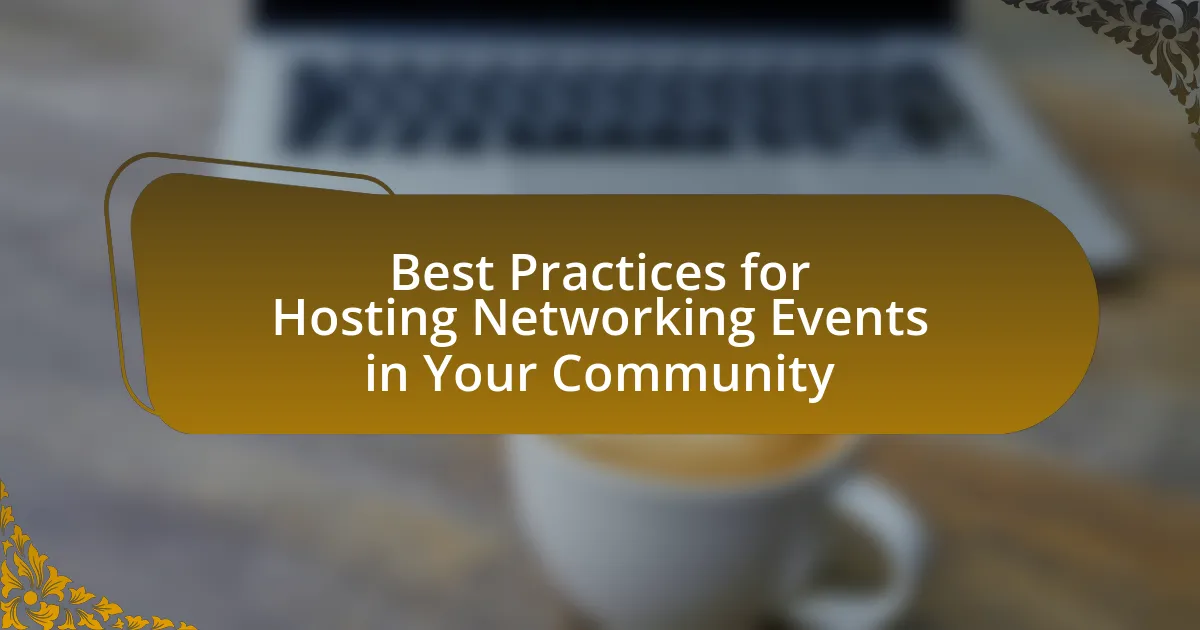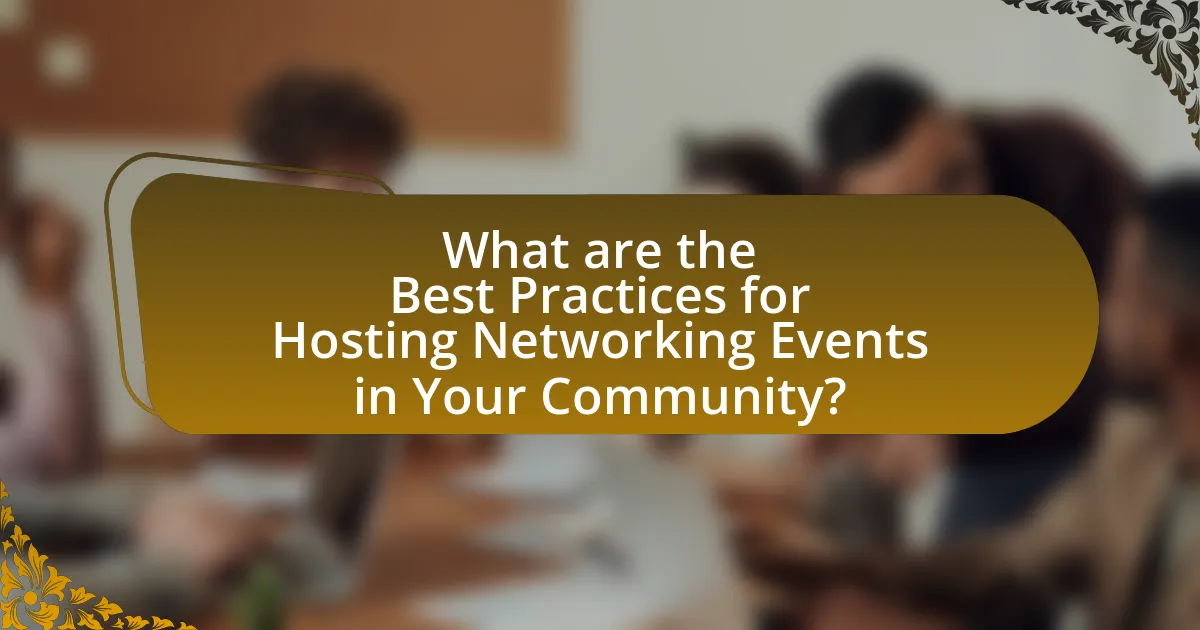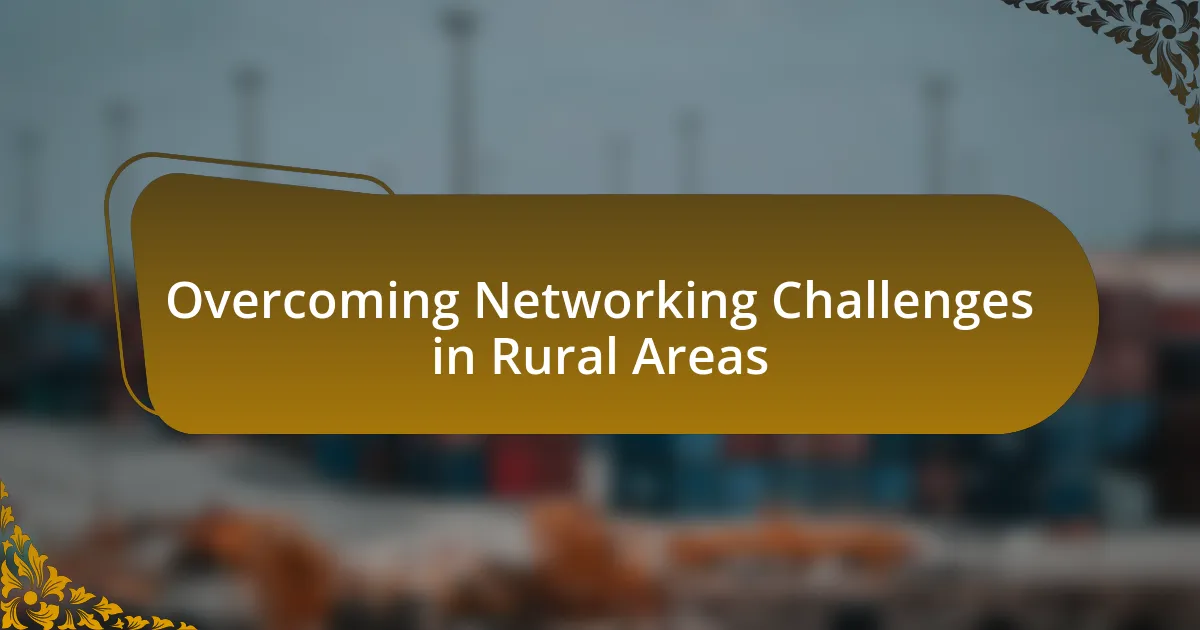The article focuses on effective networking tips for small business owners operating in competitive markets. It emphasizes the importance of leveraging social media, attending industry-specific events, and forming strategic partnerships to enhance visibility and foster valuable connections. Key strategies include identifying networking opportunities, utilizing online platforms, and maintaining professional relationships through consistent communication and follow-up. The article also highlights common networking mistakes to avoid and provides practical tips for successful networking, ultimately underscoring the role of networking in driving business growth and brand awareness.

What are Effective Networking Tips for Small Business Owners in Competitive Markets?
Effective networking tips for small business owners in competitive markets include leveraging social media platforms, attending industry-specific events, and building strategic partnerships. Social media allows business owners to connect with potential clients and industry peers, enhancing visibility and engagement. Attending industry-specific events provides opportunities for face-to-face interactions, fostering relationships that can lead to collaborations or referrals. Building strategic partnerships with complementary businesses can create mutually beneficial opportunities, expanding reach and resources. According to a study by the Harvard Business Review, 70% of jobs are found through networking, highlighting its importance in competitive environments.
How can small business owners identify valuable networking opportunities?
Small business owners can identify valuable networking opportunities by actively participating in industry-specific events, such as trade shows and conferences, where they can connect with potential clients and partners. Engaging in local business associations or chambers of commerce also provides access to networking events tailored to their market. Research indicates that 70% of small businesses find new clients through networking, highlighting its effectiveness. Additionally, utilizing online platforms like LinkedIn allows owners to connect with industry professionals and join relevant groups, further expanding their networking reach.
What types of events should small business owners attend for networking?
Small business owners should attend industry conferences, trade shows, local business meetups, and networking events specifically designed for entrepreneurs. Industry conferences provide opportunities to connect with peers and learn about market trends, while trade shows allow for direct engagement with potential clients and suppliers. Local business meetups foster community relationships and collaboration, and entrepreneur-focused networking events often feature guest speakers and workshops that can enhance business skills. These types of events are proven to facilitate valuable connections, as studies indicate that networking can lead to increased business opportunities and partnerships.
How can online platforms enhance networking for small business owners?
Online platforms enhance networking for small business owners by providing accessible channels for communication, collaboration, and relationship-building. These platforms, such as LinkedIn, Facebook Groups, and industry-specific forums, allow small business owners to connect with peers, mentors, and potential clients regardless of geographical barriers. Research indicates that 70% of small business owners find networking through online platforms to be effective in generating leads and partnerships. Additionally, online platforms facilitate the sharing of resources, knowledge, and best practices, which can lead to increased visibility and growth opportunities for small businesses.
Why is networking crucial for small business success in competitive markets?
Networking is crucial for small business success in competitive markets because it facilitates access to resources, information, and opportunities that can enhance growth and sustainability. By building relationships with other businesses, industry professionals, and potential clients, small businesses can gain insights into market trends, customer preferences, and best practices. Research indicates that 70% of jobs are found through networking, highlighting its importance in creating opportunities. Additionally, networking can lead to partnerships that provide shared resources, reducing costs and increasing market reach. In competitive environments, these connections can differentiate a small business from its competitors, ultimately contributing to its success.
What advantages does networking provide to small business owners?
Networking provides small business owners with access to valuable resources, including potential clients, partnerships, and industry insights. By engaging with other professionals, small business owners can expand their reach and visibility, which is crucial in competitive markets. Research indicates that 70% of jobs are found through networking, highlighting its effectiveness in creating opportunities. Additionally, networking fosters relationships that can lead to collaborations, mentorship, and referrals, all of which are essential for growth and sustainability in small businesses.
How does networking help in building brand awareness?
Networking helps in building brand awareness by facilitating connections that increase visibility and credibility within a target market. When small business owners engage in networking, they create opportunities to share their brand story, showcase their products or services, and establish relationships with potential customers and industry influencers. This interaction can lead to referrals and word-of-mouth promotion, which are critical for brand recognition. According to a study by the Harvard Business Review, 70% of jobs are found through networking, highlighting its effectiveness in expanding reach and enhancing brand presence in competitive markets.
What strategies can small business owners use to network effectively?
Small business owners can network effectively by leveraging local events, online platforms, and strategic partnerships. Attending local business meetups, trade shows, and community events allows owners to connect with potential clients and other entrepreneurs, fostering relationships that can lead to referrals and collaborations. Utilizing online platforms such as LinkedIn enables small business owners to expand their reach beyond geographical limitations, allowing them to engage with industry professionals and participate in relevant discussions. Forming strategic partnerships with complementary businesses can also enhance networking efforts, as these alliances can provide mutual referrals and shared resources, ultimately increasing visibility and credibility in the market.
How can small business owners create a compelling elevator pitch?
Small business owners can create a compelling elevator pitch by clearly defining their unique value proposition and articulating it succinctly. This involves identifying what sets their business apart from competitors, focusing on the specific problem they solve for customers, and conveying this in a concise manner, ideally within 30 to 60 seconds. Research indicates that effective elevator pitches include a hook to grab attention, a brief explanation of the business, and a call to action, which can significantly enhance engagement during networking opportunities.
What role does follow-up play in successful networking?
Follow-up is crucial in successful networking as it reinforces connections and fosters relationships. By reaching out after initial meetings, individuals demonstrate their interest and commitment, which can lead to opportunities for collaboration or referrals. Research indicates that 80% of sales require five follow-up calls after the initial contact, highlighting the importance of persistence in maintaining relationships. Effective follow-up can differentiate a business in competitive markets, as it shows professionalism and dedication, ultimately enhancing trust and rapport with potential clients or partners.

How can small business owners leverage relationships for growth?
Small business owners can leverage relationships for growth by actively engaging in networking opportunities to build partnerships, gain referrals, and enhance their market presence. Establishing strong connections with other businesses, industry influencers, and customers can lead to collaborative ventures, shared resources, and increased visibility. For instance, according to a study by the Small Business Administration, 70% of small businesses report that networking has directly contributed to their growth, highlighting the importance of relationship-building in driving sales and expanding customer bases.
What are the best practices for maintaining professional relationships?
The best practices for maintaining professional relationships include consistent communication, mutual respect, and providing value. Consistent communication fosters trust and keeps connections strong, as regular check-ins can help maintain rapport. Mutual respect involves recognizing and valuing the contributions of others, which strengthens bonds and encourages collaboration. Providing value, such as sharing resources or offering assistance, enhances relationships by demonstrating commitment and support. Research indicates that networking relationships thrive on reciprocity and engagement, highlighting the importance of these practices in professional settings.
How often should small business owners reach out to their network?
Small business owners should reach out to their network at least once a month. Regular communication helps maintain relationships and keeps the business top-of-mind for potential referrals and collaborations. Research indicates that consistent engagement, such as monthly check-ins, can significantly enhance networking effectiveness, leading to increased opportunities and support.
What tools can assist in managing networking contacts?
Customer Relationship Management (CRM) software can assist in managing networking contacts effectively. CRMs like Salesforce, HubSpot, and Zoho provide features for organizing contact information, tracking interactions, and scheduling follow-ups. These tools enable users to categorize contacts, set reminders for outreach, and analyze networking efforts, which enhances relationship management. According to a report by Nucleus Research, businesses that utilize CRM systems can increase sales by up to 29%, demonstrating the effectiveness of these tools in optimizing networking strategies.
How can small business owners collaborate with others in their network?
Small business owners can collaborate with others in their network by engaging in joint marketing initiatives, sharing resources, and participating in community events. For instance, they can co-host workshops or webinars that leverage each other’s expertise, thereby expanding their reach and customer base. Research indicates that 70% of small businesses report that networking leads to new opportunities, highlighting the effectiveness of collaboration in fostering growth and innovation.
What types of collaborations can benefit small business owners?
Small business owners can benefit from strategic partnerships, joint ventures, and co-marketing collaborations. Strategic partnerships allow businesses to leverage each other’s strengths, resources, and customer bases, enhancing market reach and operational efficiency. Joint ventures enable small businesses to pool resources for specific projects, sharing risks and rewards, which can lead to innovative solutions and increased competitiveness. Co-marketing collaborations involve two or more businesses promoting each other’s products or services, which can expand visibility and attract new customers. According to a study by the Small Business Administration, businesses that engage in partnerships report a 30% increase in revenue compared to those that do not collaborate.
How can joint ventures enhance visibility and reach?
Joint ventures enhance visibility and reach by combining the marketing efforts and customer bases of two or more businesses. This collaboration allows each partner to tap into the other’s audience, significantly increasing brand exposure. For instance, a study by the Harvard Business Review found that companies engaging in joint ventures can achieve up to 30% higher market penetration compared to those operating independently. By leveraging shared resources and networks, joint ventures create opportunities for cross-promotion, leading to greater awareness and access to new markets.

What common networking mistakes should small business owners avoid?
Small business owners should avoid the common networking mistake of failing to follow up with contacts after initial meetings. This oversight can lead to missed opportunities for collaboration and referrals, as maintaining relationships is crucial in networking. According to a study by the Harvard Business Review, 70% of people prefer to do business with those they know, highlighting the importance of nurturing connections. Additionally, neglecting to tailor networking approaches to specific audiences can alienate potential partners; research shows that personalized communication increases engagement by 50%. Lastly, small business owners often overlook the value of listening during conversations, which can hinder relationship-building and understanding of others’ needs.
How can small business owners recognize ineffective networking habits?
Small business owners can recognize ineffective networking habits by assessing the quality and outcomes of their networking efforts. If they frequently attend events without making meaningful connections or fail to follow up with contacts, these behaviors indicate inefficiency. Additionally, if their networking interactions lack purpose or focus on superficial exchanges rather than building relationships, this further highlights ineffective habits. Research shows that 70% of professionals believe that networking is crucial for career success, yet many report feeling unproductive in their networking activities, suggesting a disconnect between effort and results.
What are the signs of a poorly executed networking strategy?
Signs of a poorly executed networking strategy include a lack of meaningful connections, ineffective communication, and minimal follow-up. When individuals fail to establish genuine relationships, they often miss opportunities for collaboration and support, which are crucial in competitive markets. Ineffective communication, characterized by unclear messaging or failure to engage with others, leads to misunderstandings and disengagement. Additionally, minimal follow-up after initial meetings results in lost connections and opportunities for building lasting partnerships. These signs indicate that the networking strategy is not fostering the necessary relationships and interactions needed for business growth.
How can small business owners pivot from unsuccessful networking attempts?
Small business owners can pivot from unsuccessful networking attempts by reassessing their networking strategies and focusing on building meaningful relationships. This involves identifying the right networking events that align with their business goals, actively engaging with attendees, and following up with personalized communication. Research indicates that 70% of jobs are found through networking, highlighting the importance of effective connections. By refining their approach and prioritizing quality over quantity in networking, small business owners can enhance their chances of success in competitive markets.
What practical tips can small business owners implement for successful networking?
Small business owners can implement several practical tips for successful networking, including attending industry events, leveraging social media, and building genuine relationships. Attending industry events allows owners to meet potential clients and partners face-to-face, fostering trust and collaboration. Leveraging social media platforms, such as LinkedIn, enables owners to connect with a broader audience and share valuable content, enhancing their visibility. Building genuine relationships through consistent follow-ups and personalized communication strengthens connections and encourages referrals. According to a study by the Harvard Business Review, 70% of jobs are found through networking, highlighting the importance of these strategies for business growth.
How can small business owners prepare for networking events effectively?
Small business owners can prepare for networking events effectively by setting clear objectives for what they want to achieve, such as building relationships or finding potential clients. They should research the attendees and the event format to tailor their approach, ensuring they can engage meaningfully with others. Additionally, practicing an elevator pitch helps convey their business value succinctly. According to a study by the Harvard Business Review, networking can lead to significant business growth, with 70% of jobs being found through networking. This underscores the importance of preparation in maximizing the benefits of networking events.
What mindset should small business owners adopt for networking success?
Small business owners should adopt a collaborative and growth-oriented mindset for networking success. This mindset encourages them to view networking as an opportunity to build mutually beneficial relationships rather than merely transactional interactions. Research indicates that 70% of small businesses attribute their growth to networking, highlighting the importance of fostering genuine connections. By prioritizing collaboration, small business owners can leverage diverse perspectives and resources, ultimately enhancing their competitive edge in the market.
































